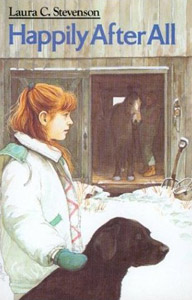A New Series: One Minute Reviews of
Books by Vermont Authors
Laura's column "One Minute Reviews" has appeared bi-weekly in Wilmington, Vermont's Deerfield Valley News since 2015. In April 2018, she found that no Vermont periodical consistently reviews all commercially published fiction and non-fiction by Vermont authors, so she started a series to fill that void. Published reviews from that series and some earlier reviews of local authors are listed with links to a scan of the printed copy. Reviews still in queue are listed without links until they appear in print.
The books reviewed in this series are available through Wilmington's Pettee Memorial Library, the Whitingham Free Public Library, and locally owned Bartleby's Books in Wilmington.
Deerfield Valley News, 4/11/2024
A Great Racehorse Rediscovered
Geraldine Brooks, Horse. Viking, 2022
In mid 19th century America, Lexington was hailed as the greatest racing stallion of all time. His beauty and power were captured by Thomas Scott, an itinerant equine painter of the era; and after his death, his skeleton became a celebrated exhibit at the Smithsonian Museum. As Lexington’s reputation faded in the twentieth century, his skeleton was shunted off to an obscure Smithsonian attic and labeled simply “Horse.” Scott’s paintings similarly disappeared from public view. Geraldine Brooks, mixing cutting-edge historical research with compelling fiction, tells Lexington’s story from the point of view of his enslaved Black groom, Jarret; she also re-creates Lexington’s rediscovery from the points of view of Jess, a young Australian woman at the Smithsonian’s Osteology Prep Lab, and Theo, a Nigerian-American art history grad student who finds a battered painting of a horse in a pile of curbside “Free Stuff.” The resulting novel is an exciting portrayal of the 1850s racing world, a glance at the importance of equine art in the days before photography, a wonderful trip behind the scenes of the Smithsonian Museum, and a poignant reflection on the racial tragedy of past and present America.
Instead of telling Lexington’s story first, then discussing its revival second, Brooks interweaves the tales in two strands, each of which illuminates the other. The book opens with two short opening chapters in 2019, in which the Theo and Jess become connected with the portrait and the skeleton. The next chapter is set in 1855 Kentucky where it portrays the part of teenaged Jarret and his father in Lexington’s violent conception and successful birth. Back in 2019, Theo temporarily forgets about the salvaged painting; two pages later, Thomas Scott arrives at the Meadows (Lexington’s home) in 1855 and promises to paint the new colt for Jarret in return for his help preparing another horse for a portrait. Intertwined also in these chapters is the book’s ongoing theme: Theo has resigned from the Oxford polo team over a racial slur, and Jarret has reflected that Scott, a northerner, sees only the well-run peace of the Meadows, but “It was what you couldn’t see that rubbed your soul raw.” Here, as elsewhere, Brooks’ portraits of racial injustice are as brief as they are candid. With one shattering exception, she avoids portraying visible horrors in favor of making her readers vicariously experience the prejudices, restraints and casual betrayals that rub her Black characters raw.
The intertwined chapters (briefly given an extra strand in the 1950s, as Lexington’s portrait arrives in a gallery of ultra-contemporary art) are enhanced not only by scholarship but by the nuance with which Brooks portrays Theo and Jess’s developing romance. It begins unpromisingly with Jess’s knee-jerk assumption that Theo is trying to steal her expensive bicycle; Theo replies politely that the bike he’s unlocking is his, and that hers is a few feet away. Horrified, she stammers a shamed apology—the only one in the book. Equine paintings accidentally bring them together again, and amidst the professional talk, they develop a friendship that reaches beyond their social differences and becomes a mutual love that contrasts poignantly with Jarret’s spiritual loneliness.
This is a wonderful book: exciting, infuriating, thoughtful, occasionally heartwarming and, in its final chapters, heartbreaking. Its technique recalls the observation of Theo, who, studying the meticulously portrayed Black grooms in the equine paintings of Scott and his contemporaries, realizes that it was possible for White men to see—and thus, to paint—Black men as human beings instead of unthinkingly relying on racial stereotypes. Brooks’ portrayal of the daily injustices besetting her Black characters is demonstrates the same perceptive and compassionate vision.


